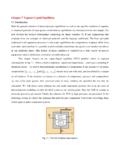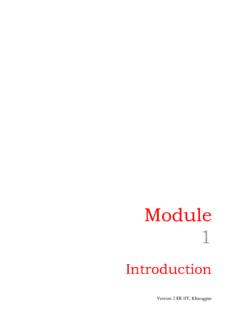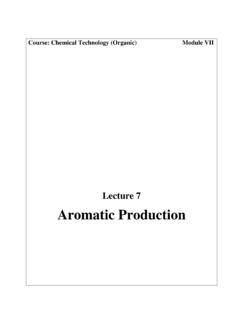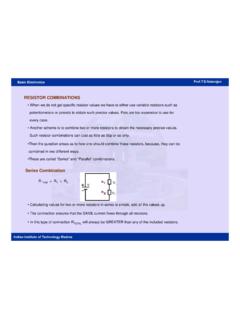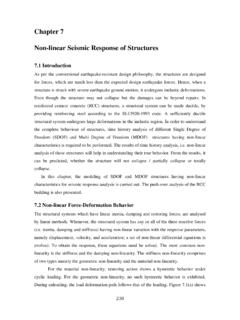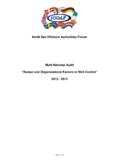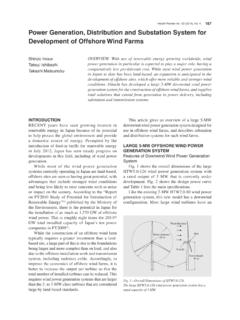Transcription of Health, Safety and Environmental Management in Petroleum ...
1 Health, Safety and Environmental Management in Petroleum and offshore Engineering Prof. Dr. Srinivasan Chandrasekaran Department of Ocean Engineering Indian Institute of Technology, Madras Module No. # 01 Lecture No. # 08 Hazard Identification and Management in oil and Gas industry using HAZOP (Refer Slide Time: 00:10) Ladies and gentlemen, now we will continue with module one lecture eight. In this lecture, we will explain you how to conduct in detail an HAZOP study for a specific example, which I will illustrate you step by step. So, this lecture is dedicated to hazard identification and Management in oil and gas sector using HAZOP methodology. Let us quickly recapitulate why and what are all the important factors which lead us to do HAZOP study. Oil and gas industry plays a major role in world's economy. Huge investments are made to upkeep the facilities in order to increase the production capacity, even marginally.
2 Any accident like blowout, oil spill, operational problems, shall cause heavy economic loss to the industry. Several techniques are available to identify and assess these hazards. For example, hazard and operability study which we call as HAZOP which are now focusing in the present lecture. Failure mode effect analysis which is called FMEA, which we will discuss in the subsequent lectures. Quantitative risk assessment (QRA), which we will discuss in the next module. Event tree analysis and fault tree analysis - ETA and FTA respectively which we will discuss in the subsequent modules. (Refer Slide Time: 01:47) Let us quickly recapitulate that HAZOP is actually applicable at four stages of operation. You can apply HAZOP at the drawing board stage which we call as a design stage. You can also apply HAZOP at the construction stage or the process stage.
3 You can also apply HAZOP when you want to make any process modifications or finally, you can also do an HAZOP study once the accident has occurred. We specifically call this kind of action as accident investigation report - AIR. (Refer Slide Time: 02:27) Now, I want you to take through a case study which we will discuss and prepare an HAZOP report for this case study. This is actually an application problem of a group gathering station. I hope you all understand what do I mean by a group gathering station. I will explain very briefly what is the segment of analysis of a GGS considered in the present study. I have identify group gathering station and tried to located the hazard and operability problems of that station because a group gathering station in general has potential to cause damage to the operation plant personnel and environment as well.
4 So, the objective of this study could be to eliminate or to reduce the probability and consequences of incidence. Remember the catch word here is not an accident. Incident is related to hazard, hazard is a scenario. As long as the hazard or the scenario is not realized into an accident, there is no risk. So, to eliminate or reduce the probability and consequence of incidents in the installation and an operation of a group gathering station. So, this HAZOP study is applied to a GGS at the installation and operation stage itself. I have used a software by name PHA-pro version 7 for preparing the HAZOP worksheet. Ladies and gentlemen, you can recollect that HAZOP worksheet can be recorded in two formats. You can have a full recording format which includes all possible deviations from the design intent given therefore, the report is very comprehensive.
5 So, here what I am describing to you is a full recording format of an HAZOP worksheet which is prepared or generated using a software by name PHA-pro version (Refer Slide Time: 04:44) Let us quickly go through the methodology how this case study was done. In a given group gathering station from the piping and instrumentation diagram given to you in detail, study carefully the P and I diagram and identify at least one section of the plant. Now, we call this section identified as node in the study. Now, for that identified section of the plant of the group gathering station define the design intent and the normal operational conditions of this section. Once you have defined the design intent then identify subsequently at least one deviation of this design intent or operating conditions by now applying a system of guide words.
6 Ladies and gentlemen, recollect that the guide words are primary and secondary keywords which we discussed in the last lecture. Try to make a list of possible keywords which can be appropriately used for the selected problem like a group gathering station. Pick up those appropriate keywords and try to list them before you start doing an HAZOP study. Then identify the possible causes related consequences and existing safeguards for the identified deviations. Based on your detailed investigation carried out on this level, suggest or recommend actions to reduce or to eliminate these deviations. Finally record the complete discussions you have or you intend to have with the Management and also what recommendations you propose in terms of reducing or eliminating or mitigating the envisaged risk on the plant.
7 These are as 8the following six steps of what we will do to carry out the HAZOP report for the case study of the group gathering station. (Refer Slide Time: 07:05) Now, the case study considered is a group gathering station I have a figure of the station in the next slide. (Refer Slide Time: 07:15) So, this is the group gathering station. I will explain this process very quickly using this figure then I will explain what is actually happening in each of them slightly in detail. This is a process and flow diagram of a GGS. There are many manifolds which supply oil from the wells which are a type of non enhanced oil recovery feed. I call them as group header, because the name group header qualifies that this is a header which collects from different groups of wells in one. So, I can have many number of group headers.
8 Here in this P and ID, I have got two set of group headers - group header one and group header two. The group header one and two receive the oil supply from the drilling well to this collection point. From the group header one and two, the substance or the content starts flowing to what we call as bath heater. There are many bath heaters located in this scenario, there are about five in numbers. I simply say one to five. The purpose of a bath heater is, it will separate oil, water, and gas from the accumulated substance from group header one and two. To do this, I need a chemical dosing tank for enhancing this process. So, I supply a dosing chemical from this tank to this bath heater. This diagram do not show any of the instrumentation and the valves located because this is simply a process flow diagram. If you want to look at the location of valves and other pressure gauges and instrumentations in the system you should look at what we call as process and instrumentation diagram.
9 So, from the PFD diagram once the substance is collected in the bath heaters which is separating oil, water, and gas from the inlet substance the gas collected is transferred to what we call as flare stack. The oil collected and the water together will be sent to what we call as enhanced recovery tank. The recovery tanks ER, there are about five to eight in numbers in this process. Then the substance is forwarded further to what we call as jumbo heater. The jumbo heater again further purifies oil and water, and whatever content of water has been separated, it has been taken to what we call as ETP. ETP is effluent treatment plant. The oil purified here or separated here is collected in a storage tanks one to four, from the storage tanks one to four the oil is further dispatched through the pump house to a common tank facility from where it will be distributed.
10 So, this is one segment of the process and flow diagram, which is under the present scope of study. These are the nodes which I keep on marking in my P and FD. So, the well fluid emulsion received at the limits of GGS is distributed to three production manifolds. From the main group header well fluid goes to the bath heaters for the first stage of purification where they separate oil, gas and water. The separated oil is subsequently stored in the emulsion recipient tanks, which are called as E R tank associated gas is then separated out and sends to what is called flare stack. The separated water goes to effluent treatment plant what we call as ETP. From the emulsion recipient tank, oil is then subsequently fed to jumbo heater through the feed pump, for further refined treatment. In jumbo heater, further separation of oil and water takes place.
